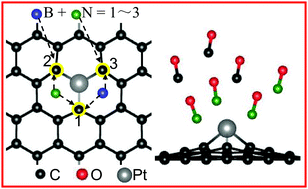Theoretical study on the adsorption and electronic properties of toxic gas molecules on single-atom Pt-doped B/N-coordinated graphene†
Abstract
The geometric stability, electronic and magnetic characteristics of the single-atom metal (SAMs) Pt-anchored graphene by controlling the coordinated B and N atoms (xB–yN–graphene-Pt, x + y = 1–3) are studied using first-principles calculations. It was found that the xB–graphene-Pt configurations are more stable than that of yN–graphene-Pt. The formation of a single vacancy within the graphene-supported Pt atom (SV-graphene-Pt) and xB–yN–graphene-Pt sheets exhibited high thermodynamics stability. Compared to the SV-graphene-Pt, the single NO and CO anchored at the xB–yN–graphene-Pt sheets are more stable (without 3B–graphene-Pt), and the high stability of NO-adsorbed systems exhibit various magnetic properties. In comparison, the coadsorption stability of 2NO or 2CO decreased at graphene-based substrates, and these adsorbed gases at 3N–graphene-Pt are the most stable configurations, illustrating that the positively charged Pt catalyst exhibits the most activity. Moreover, the different types and number of gas adsorbates can regulate the electronic and magnetic properties of xB–yN–graphene-Pt systems. The high stability of NO and 2NO can more effectively turn the magnetic property of adsorbed systems than that of the adsorbed CO or 2CO. These results provide an important reference for regulating the reactive activity of SAMs on graphene-related materials for toxic gas molecules.



 Please wait while we load your content...
Please wait while we load your content...